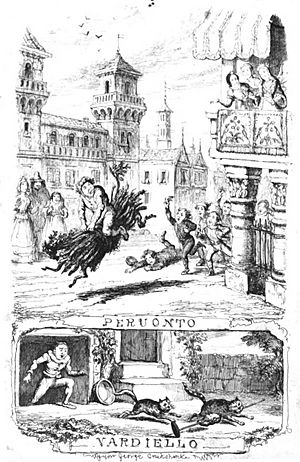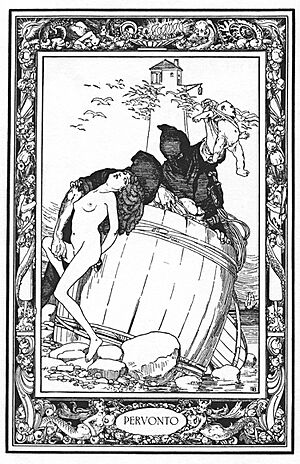Peruonto facts for kids
Quick facts for kids Peruonto |
|
|---|---|
| Folk tale | |
| Name | Peruonto |
| Data | |
| Aarne–Thompson grouping | ATU 675 (The Lazy Boy) |
| Region | Italy |
| Published in | Pentamerone, by Giambattista Basile |
| Related | At the Pike's Behest The Dolphin Half-Man Foolish Hans (de) Peter the Fool (fr) |
Peruonto is an Italian fairy tale written by Giambattista Basile. He included it in his book, the Pentamerone, in 1634. This story is about a simple young man who gains a magical power. This power helps him change his life in surprising ways.
Contents
The Story of Peruonto
A widow named Ceccarella had a son named Peruonto. He was not very smart and was quite clumsy. One day, his mother sent him to collect wood. While in the forest, he saw three men sleeping in the sun. Peruonto kindly built a small shelter of branches to shade them.
These men were actually the sons of a fairy. When they woke up, they were grateful for Peruonto's kindness. They gave him a special charm. This charm meant that anything Peruonto wished for would come true.
As Peruonto carried the wood back home, he wished the wood would carry him instead. Suddenly, the bundle of sticks lifted him up! He rode it like a horse. The king's daughter, Vastolla, saw this strange sight. She was known for never laughing, but she burst out laughing when she saw Peruonto. Peruonto then wished that she would marry him. He also wished that he would cure her of her laughter.
A Royal Problem
Vastolla was supposed to marry a prince. But she refused, saying she would only marry the man who rode the wood. The king was very angry. His advisors told him to find the man instead of punishing Vastolla.
The king held a big feast for all the nobles. He hoped Vastolla would point out the man. But she did not recognize anyone. The king was ready to punish her. However, his advisors suggested another banquet for people of lower birth. Peruonto's mother encouraged him to go. He went, and Vastolla immediately recognized him.
Thrown into the Sea
The king was furious. He had Vastolla and Peruonto put into a large wooden barrel. Then, they were thrown into the sea. Inside the barrel, Vastolla cleverly got Peruonto to tell her about his magic charm. She then told him to wish for the barrel to become a ship.
Next, she had him wish for the ship to turn into a beautiful castle. Finally, she asked him to wish for himself to become a handsome and polite man. Peruonto made these wishes, and they all came true. They got married and lived happily in their new castle for many years.
Reunion with the King
Years later, Vastolla's father, the king, grew old and sad. His advisors encouraged him to go hunting to cheer up. One day, he came across a magnificent castle. He found only two young boys inside. They welcomed him and offered him a magical feast.
The next morning, the king wanted to thank them. Not only the boys appeared, but also their parents: Vastolla and Peruonto! The family was reunited and very happy. The king brought them back to his own castle. They celebrated with a huge feast that lasted nine days.
Similar Stories Around the World
The story of Peruonto is part of a group of fairy tales known as ATU 675. This type of story is about a "Lazy Boy" who gains magical wishes. These tales are told all over Europe. They are especially popular in Eastern Europe.
Other Literary Versions
Many other writers have told similar stories. For example, Giovanni Francesco Straparola wrote "Peter The Fool." Madame d'Aulnoy wrote a tale called The Dolphin. These stories also feature a simple character who gains special powers.
Folk Tales from Different Countries
- France: A French version is called Half-Man. Another Breton story, Kristoff, takes place in the legendary city of Ys. In a French tale from Albret, "Le Bon Dieu" (God) gives the hero his wish-granting power.
- Portugal: In a Portuguese story called The Baker's Idle Son, a magical pike helps the lazy boy. The pike later turns into a man and marries the princess.
- Italy: In Sicily, Giuseppe Pitre collected a story called Lu Loccu di li Pàssuli e Ficu. In this tale, the foolish character loves figs and raisins. He gets his magic powers from nymphs in the woods.
- Germany: In a German story, Der dumme Michel, the king's grandson helps find his father. He insists that every man in the kingdom be invited to a gathering.
- Denmark: Danish versions include Onskerne ("The Wishes") and Den dovne Dreng ("The Idle Youth"). In one, a frog gives the hero unlimited wishes after he is released.
- Finland: Over 160 versions of this tale type exist in Finland. It is one of the most popular Finnish folk tales.
- Estonia: This type of story is also very popular in Estonia.
- Bulgaria: In Der Faulpelz, oder: Gutes wird mit Gutem vergolten ("Lazybones, or: Good is repaid with good"), a lazy youth puts a fish back in the ocean. The fish teaches him a spell to make wishes come true.
- Romania: A Romanian version, Csuka hírivel, aranyhal szerencséjivel, features a Romani youth. He releases a goldfish that teaches him a magic spell.
Modern Adaptations
The story of Peruonto has inspired other works.
- German poet Christoph Martin Wieland wrote an opera called Pervonte oder Die Wünschen ("Pervonte, or the Wishes").
- A Hungarian version of the tale was made into an episode of the TV series Magyar népmesék ("Hungarian Folk Tales"). The episode was titled A rest legényröl ("The Lazy Boy").



